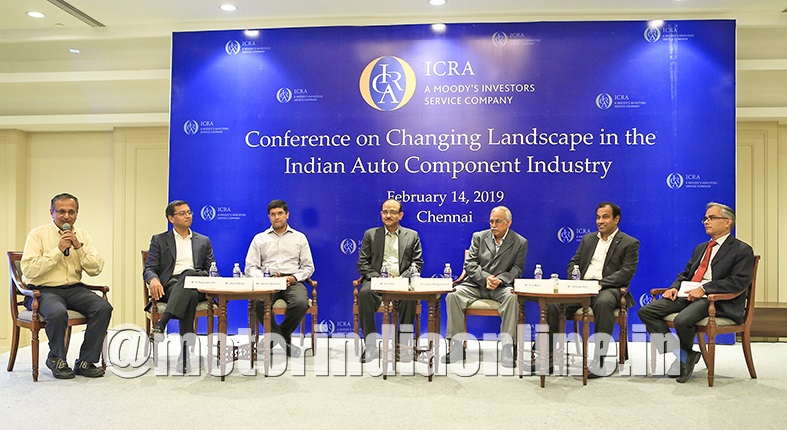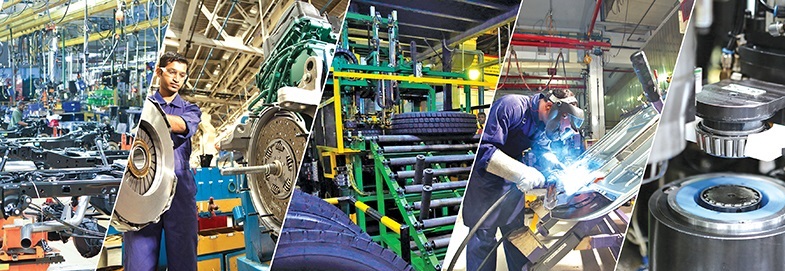The Indian auto component industry has grown at a healthy CAGR of around 8.3% from FY2014 to FY2018 driven by steady demand from OEMs, aftermarket (replacement market) and exports. The industry’s aggregate revenues have grown from Rs. ~ 2.32 lakh crores to ~ Rs. 3.45 lakh crores, according to ACMA sources. As per ICRA’s comprehensive presentation note titled “Indian Auto Component Industry, the Way Forward,” the growth trajectory of the ancillary universe which broadly tracks OE growth is likely to be higher than the underlying automotive industry growth.

In terms of composition of auto component industry, passenger vehicle and two-wheeler components account for about two-thirds of the OE consumption (including imports) by value. The industry majorly exports to Europe which account for 34%, followed by the US at 23%. As for imports, mostly Indian imports comprise of child-parts and sub-components from Europe which is the largest source market with 30% share, followed by China with 27% share.
Says Mr. Subrata Ray, Senior Group Vice President, ICRA: “Over the next 3-5 years demand for components is likely to grow by 9-11%. OEM demand for components would be supported by increasing localization by OEMs and higher component content per vehicle. Indian exports have grown at a CAGR of 7% over the past five years ending FY18. Future export growth will depend on global demand for vehicles and Indian inroads into newer products and global platforms.”
ICRA notes that currently there is a significant gap between Indian component manufacturers and global peers, in terms of scale and product complexities. However, as Indian emission and safety requirements tighten sharply in the coming years, this gap should gradually reduce.
As per estimates by the Society of Indian Automobile Manufacturers (SIAM), an investment of Rs. 1 lakh crore is required for upgrading to BS-VI, with 30-40% coming from component manufacture. The past three years has already seen high investments for supporting new products and capacities. This is likely to continue to evolve and grow with changing regulations. Capital expenditure by the auto component industry is likely to stay at ~7-8% of sales over the next three years compared to 4-6% of sales for global majors. However, the credit profile of Indian auto component suppliers is healthy with sizable liquidity to support capex.
For the Indian auto component industry to grow, a supportive policy framework is critical. Incentives for R&D investments and a supportive framework for electric vehicle transition is imperative. A clear road map and continuation of the FAME (Faster Adoption and Manufacture of (Hybrid and) Electric Vehicles)) Scheme would help the industry firm up its own electric powertrain investment plans.
Coming to revenue forecasts, the Indian auto component industry is likely to post healthy revenue growth in FY 2019 driven by higher realization and increased content per vehicle. As per ICRA estimates, the industry revenues are estimated to grow by 10-12% between FY2018 to FY2022 while the average industry operating margin range will be 13.5%-14.5% over the near term. Buoyed by low leverage and strong accruals in Indian operations, tier-I suppliers are exploring inorganic growth for technology and customer acquisition.
Commenting further on the outlook, Mr. Subrata Ray observes: “The credit ratio of ICRA’s rated portfolio of auto ancillaries has improved with upgrades surpassing downgrades for the sixth consecutive year, YTD FY2019. The industry outlook is stable despite the heightened capex requirements and the pressure from emerging technologies.”
ICRA further states that the industry is currently in the midst of a technology transformation. Development of new emission technologies and safety norms would entail significant incremental investments and a ramp up in R&D or technology sourcing.
The ICRA report mentions that regulation-driven demand for safety features is leading to higher cost of safety. While this will eventually reduce with scale economies, increasing localisation will be a key challenge.
It is estimated that the electronic content in vehicles will reach 25-40% by 2030, driven by safety, emission and technological disruptions like connectivity. The shift to the BS-VI norms will also lead to rapid increase in demand for vehicle electronics. Currently the Indian auto electronics space is dominated by global technology majors with few Indian players. The challenge for Indian component manufacturers would be increasing localisation as import content in electronics is at present high at 60-70%.
As manufacturing platforms consolidate, commonality (usage) of parts will provide scale benefits to component manufacturers. However, they would need to do sizable investments in capacity creation.
Navigating complex and changing competitive landscape would require auto ancillaries to adopt a multi-pronged approach. Subsequently OEMs are increasingly opting for modules and sub-assemblies as against manufacturing individual components. Vendor rationalisation through increased tierisations is emerging wherein Tier-1s (and the OEM) have to ensure that the downstream supply chain is capable of supporting their demand. Therefore, the ability of Indian ancillaries to transit to module and system suppliers and compete with deep-pocketed and technology-rich global majors will matter.
“The industry would need to commit significant resources for these emerging technologies and simultaneously navigate investments in current businesses. The interplay between emission, electrification, safety and electronification is expected to increase use of electronics in vehicles. Focus on localisation of components and technologies is a key area of investment for the industry. This would require a higher R&D to sales spend for Indian ancillaries. The average R&D/sales for top global majors is ~7% as against sub 1% for India. Further, capex would have to stay consistently high at 7-8% of sales over the next three years as witnessed during FY16-18,” concludes Ms. Pavethra Ponniah, Vice President and Sector Head, ICRA.
